Santa Cruz Island Reserve is located on the largest of roughly 25 miles from Santa Barbara, California’s eight Channel Islands off the Southern California coast. The island has two major mountain systems flanking a central valley that formed along an active fault zone. The mountains are rugged and cut by steep-sided canyons, some with perennial streams and freshwater springs. The coastline is mostly steep and rocky, with some protected coves and sandy beaches. Diverse habitats include rocky intertidal zones, coastal sage scrub, chaparral, grasslands, oak woodlands, and bishop pine forests. The reserve contains breeding grounds for harbor seals, seabird nesting colonies, many endemic plant and animal species, and well-preserved archaeological sites. Santa Cruz Island Reserve is protected, owned, and managed by The Nature Conservancy (TNC); the remainder of the island is managed by the National Park Service as part of Channel Islands National Park.
Origins
The oldest of the UC Santa Barbara Reserves, Santa Cruz Island Field Station was established by UCSB in 1966 It joined the UC Natural Reserve System in 1972. Located on Santa Cruz Island which is owned by The Nature Conservancy and the U.S. Park Service, the Reserve has worked effectively with these partners to support successful restoration projects on the Island.
Location
Twenty-four miles long and seven miles at its widest, Santa Cruz Island is the largest of California’s eight Channel Islands lying approximately 20 miles off the Santa Barbara coast. The most rugged and topographically diverse, the Island landscapes reflect what California must have looked like a century ago. A pine forest evokes the Sierra Nevada, and the Island’s stunning beaches, Baja California. The central valley that runs the length of the Island, belies its island setting.
Research Areas
The Island supports the greatest number, 627, of vascular plants on any California island, including 37 Channel Island endemics and eight Santa Cruz Island endemics. Areas of Chumash activity on the West End of the Island are importantarcheological research sites. Campaigns spearheaded by The Nature Conservancy and the U.S. Park Service have resulted in the complete removal of feral sheep and pigs, cessation of cattle ranching, removal of feral European honeybees, reintroduction of bald eagles, and recovery of the Island fox; current efforts focus on removal of non-native vegetation.
Facilities and Uses
A dormitory and common areas for kitchen and dining, boats and land vehicles make Santa Cruz a popular and well-used site for researchers, graduate students and university-led classes from around the world who visit to study island biology, geology and archeology. Public outreach programs for school children and adult visitors involve hands-on exotic plant removal and native habitat restoration projects.
Fast Facts
Administering Campus: UC Santa Barbara
Established: 1966
Location: Santa Barbara County, in the Santa Barbara Channel; 32 km (24 mi.) long by 9 km (6 mi.) wide; 19 mi. southwest of Ventura, CA.
Size: 18,652 hectares (46,090 acres), on the portion of the island owned by The Nature Conservancy
Elevation: 0 to 742 m (0 to 2,434 ft.); Reserve field station located at 61 m (201 ft.)
Average Precipitation: 50 cm (20 in.)/year in central valley of island
Temperatures Range:
Mean monthly maximum: 22ºC (71ºF)
Mean monthly minimum:10ºC (50ºF)
